 ___A HISTORY OF THE SHOW___
___A HISTORY OF THE SHOW___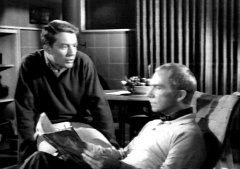
MY FAVORITE MARTIAN
 ___A HISTORY OF THE SHOW___
___A HISTORY OF THE SHOW___
BEGINNINGS
The William Morris agency put together the deal for My Favorite Martian, pairing creator John L. Greene with producer Jack Chertok. According to a 1963 article in the Rocky Mountain News, producer Chertok was looking for a TV project and he found Greene’s My Favorite Martian pilot teleplay at the bottom of a pile of scripts at the Morris agency. Chertok announced that he liked the idea, much to the dismay of the agency men who told him that the premise for such a series had been read and rejected by every producer who had ever seen it, "-and it always winds up at the bottom of the stack." Chertok replied, "That’s why I want it." *
*Added 3/26/01
Ray Walston and Bill Bixby were the immediate choices for the lead roles, (with Bill Bixby securing the role when on arriving for his interview with the producer, he shook hands, saying, "Hello, I’m Bill Bixby." and Chertok replied, "No, you’re not. You’re Tim O’Hara."). However, the part of the landlady was originally envisioned as an older woman, but when Pamela Britton interviewed for the role, she successfully convinced the producer that Mrs. Brown should be more youthful, as it would allow greater possibilities for some romance in the stories.
UNAIRED PILOT
The pilot was filmed in late 1962 and bought by CBS in Jan 1963. Longer in running time than could be allowed when it was aired as the first episode, the original pilot contained a scene where Tim stops his car on the way back from the crash site in order to call in his story (about a UFO passing the X-15) from a roadside phone. Also included is a short scene showing how the Martian uses a levitator device to move his spaceship from a U-Haul trailer into Tim's garage.
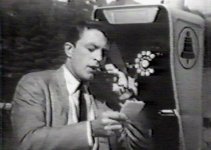 __________________
__________________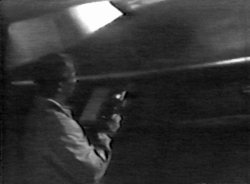
After the pilot was sold, it was decided to change Mrs. Brown's daughter from a twenty-four year old to a fifteen year old. This caused a number of scenes to be reshot, with Ann Marshall now in the role of daughter Angela and Ina Victor now playing the "twenty-something" visiting niece Annabelle. Also reshot was a crucial scene where Tim is confronted by Murphy, the Air Force official who is demanding to know how the reporter got the UFO story. In the original pilot the question of revealing a news source in the name of "patriotism" is brought up. In the redone scene, that reference is dropped, along with the Martian's use of Italian to speak to Murphy. Interestingly, snatches of dialogue from these lost scenes appear in the first MFM comic book.
 _____________
_____________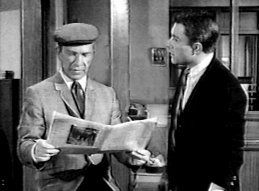
The pilot premiered on CBS Sunday, Sept. 29, 1963 at 7:30PM EST to enthusiastic reviews, earning a rating of 20.3 with a 33 share. The Oct 9th 1963 Los Angeles Herald-Examiner reported My Favorite Martian as number 1 in its viewer poll for best new series.
EARLY PRODUCTION
Since My Favorite Martian was an independently produced show, sound stage facilities were rented from Desilu, and the first 7 shows were filmed at Desilu's Cahuenga Studios, with the early set featuring a portable fireplace in the middle of the living room. When filming was moved to Soundstage 10 on the Desilu Gower lot, the fireplace was transferred to the corner of the living room.
One of television’s most attractive and identifiable sets, the terraced apartment above a garage next door to Mrs. Brown’s house did not appear architecturally correct, since on exterior shots, the section with the bedroom was not apparent, although it was visually alluded to in other exterior scenes. This was because the two story structure was a façade, utilized only for exterior shots which often featured the car in the driveway or the spaceship in the garage. The interior apartment was a separate set with its own terrace, enabling some exterior vantage points to show the living room inside the house.
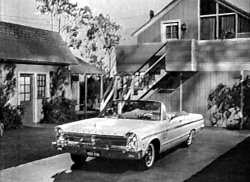 _______________
_______________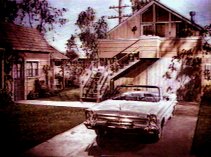
Note the changes in the doorway and terrace window from the B&W set to the one used in the color episodes.
Behind the scenes, Sherwood Schwartz (best known for creating Gilligan’s Island in 1964) came in as consultant for seven shows. Production shut down for 21 days, and ten scripts were abandoned in an effort to reach the right formula and familiarity with the actors.
One example of an unused script from those pre-production days was a teleplay entitled "Do Me A Favor, Don’t Do Me Any Favors" from May 1963, which dealt with how Martin carried out some harmless deceptions in order to create two big news stories for Tim. Another script, "The Unsuitable Suitor", dated June 1963 involved teenager Angela Brown objecting to the possibility of her mother getting married to a gentleman friend. Martin’s attempt at intervention resulted in him becoming the object of the landlady’s affection.*
These two unfilmed scripts reflected the CBS network’s imposed character change for Mrs. Brown’s daughter. In the May 63 "Do Me A Favor" script, Mrs. Brown refers to Annabelle, her 24 year old daughter who was featured in the unaired pilot. But the June 63 script centered on her 14 year old daughter named Angela, played by Ann Marshall, who was the core character for the "Suitor" plot. Indeed, very early publicity for the show in July 63 included references to the Angela character that seemed based on this unfilmed script. It was probably around this time that key scenes in the pilot were re-shot to now include Angela Brown.*……………………………………….........................…*Added 8/16/07
But after having appeared in the pilot and two other episodes, the character of Mrs. Brown’s daughter Angela was dropped without explanation. Tim’s boss at the Los Angeles Sun, Mr. Burns, played by J. Pat O'Malley, was a semi-regular character in the first season.
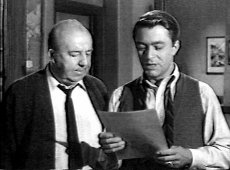 _______________
_______________
Tim O’Hara was originally slated to have a new neighbor named Jennifer (played by Kathy Kersh) become his steady girl friend. Jennifer was supposed to become quite serious about Tim, who did not want to get married—yet. But that story line and her role were abandoned, allowing bachelor Tim the freedom to date a variety of girls throughout the series. The character of Jennifer appeared only in the "How to Be a Hero" episode, and was never featured again.*
*Added 6/28/02
But even the theme of having a different girl friend for Tim each week was phased out by the producer, in favor of dealing with stories about the Martian’s adventures and abilities. "Fans only wanted to see the Martian do his tricks," remarked Mr. Walston, in an April 1964 interview with the Boston Sunday Advertiser.
*Added 11/25/02
James Komack, who had worked with Ray Walston on Broadway in "Damn Yankees", wrote twelve scripts in all and directed two. It was reported that his "How You Gonna Keep Them…" script was going to be a two-part episode, but it ended up being filmed as a regular show. A behind-the scenes story of classic TV lore which is still used to cite network omnipotence came about when CBS sent back one of Komack's scripts with a memo declaring, "A Martian wouldn't say that."
The network also opposed making the series "too intellectual". According to Mr.Walston, CBS took the position that, "This is a comedy show, let’s keep it that way…" and when it came to incorporating current space age terminology into the scripts, "..producer Jack Chertok wanted no part of it."
*(Boston Sunday Advertiser) Added 11/25/02
Due to the closing scene of the pilot, viewers were led to believe that the next episode would be about the Martian and Tim going to Las Vegas in order to raise money to buy materials for repairing the spaceship.This episode never happened. The reason for that was addressed in a newspaper interview the next summer which expressed the view that showgirls and dice games had no business on a show designed for family audiences. Plus, there was the fact that the writers had not been able to figure out a way to craft the story without seeming to condone "cheating".
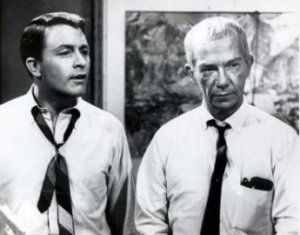 ©AP____________________
©AP____________________ ©AP
©AP
Behind the Scenes: "Nose For News" (1st Season)
…………………_Behind the Scenes: "Nothing But the Truth" ** ( 2nd season)1964 Production Call Sheet…(added 11/15/03)
Throughout the series everyone worked a backbreaking, grueling schedule. Unlike other TV shows which rehearsed 3 days and filmed 2 days, or rehearsed 4 days to film one day before a live audience, My Favorite Martian filmed on all 5 days of the week because it was saddled with time-consuming special effects. For this reason, the actors were compelled to film with virtually no rehearsal. If filming on an episode was completed at 2:30 PM, the next shows' scripts were thrust into the actors’ hands, with just a run-through for the camera, and the actual filming began again. Mr.Walston had said that they sometimes did 75 set-ups a day.
In an interview from the March 1965 issue of TV Star Parade, Bill Bixby mentioned, "…one week when Ray had the flu, we shot my scenes in five different shows while waiting for him to come back. We had three different directors for the shows in completely unrelated scenes and stories!" *
* Added 4/21/00
Production for Season One, completing 37 shows, continued through April 1964 with costs reported at $57,000 an episode. "Martian" stayed in its Sunday 7:30 PM EST time slot throughout its three year run.
It would be a disservice to reveal all the camera tricks used on the show, but suffice it to say that the silver painted spaceship was originally built of wood, enabling it to be light enough to be lifted for "take-off". But it was recast by Joe Lombardi using a stone mold into fiberglass with a steel underskeleton, resulting in a ship weighing upwards of 400 lbs. This became a problem while shooting the episode Rocket to Mars, when, as the vehicle was raised to almost 60 feet high, one of the three steel cables flying the ship, broke, almost killing Ray Walston's stand in who was riding inside it. As a result, when the shot was restarted, they chose to leave the cockpit empty, as Mr Walston would not allow them to endanger his stand in/assistant.*
*(added 4/26/05 with sincerest thanks to Peter Greenwood)
 …………….….
…………….….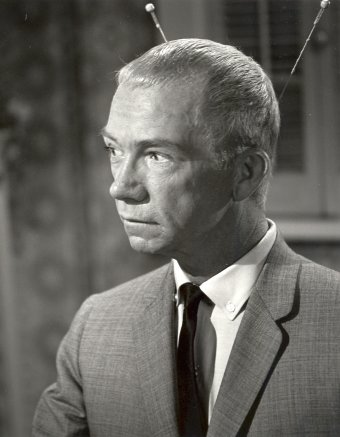
The Martian's antennae operated by remote control (As an aside, when invited guest Ray Walston visited the Mission Control space center in Houston, the NASA engineers all wanted to know the details of just how the antennae were made to work).
Ray Walston’s Visit to NASA’s Mission Control
SOUND EFFECTS
According to the book "TV’s Biggest Hits" (Schirmer Books, 1996), a musical instrument, a combination of a thermin and ondes martinet was used to provide the sounds which accompanied the Martian's antennae rising or when he used his levitation powers. This same instrument's sounds were incorporated into parts of George Greeley's musical scores as well.
RATINGS
The pilot earned a rating of 20.3 and by Oct. 29, 1963, MFM was ranked #18 with a rating of 22.2. By Nov. 29th it had gone to #9 with a rating of 26.3. During the next month, it stayed in the lower ranking of the top ten shows, usually beating out the first half-hour of Disney's Wonderful World of Color. It continued to rise in the Nielsens during January 1964 with 28.4 and #9 rank. The following rating period for the end of January and early February brought it to 29.7 for a rating of #8. Its highest rank came for the two weeks ending Feb 23, 1964 when MFM reached #5 with a rating of 31.6. It continued earning ratings around 27.0 through April and according to the Nielsen final order for the 63-64 season, My Favorite Martian ranked # 10 of all primetime programs with an overall average rating of 26.3.
In 1965, the journal of Elementary English (Feb 1965) published the results of Paul Witty's survey of Favorite 1964 TV Programs among school pupils. Students in grades 2-3 ranked My Favorite Martian #1 of all shows, while those in grades 4-6 rated The Dick Van Dyke Show as #1 and "Martian" as # 4. High School students in grades 11-12.picked Bonanza as their #1 choice and ranked MFM in a tie for 10th place with Twilight Zone, The Defenders and Hootenanny.
SOME OBSERVATIONS
The Martian’s variety of powers were introduced slowly. At first he seems only able to read minds and project thoughts, communicate with animals, and become invisible. Levitation was then introduced. It was decided that Martians have no fingerprints. By the end of the first season, he could also "freeze" people’s movement, project hypnosis and electrical energy, and tune in on radio frequencies. The second season revealed he could also generate force fields, dream in two dimensions, project images from the "mind's eye", as well as use "digital levitation" for the manipulation of molecular structure.
Contrary to belief, there was never an on-going "romance" between the Martian and the landlady. While it was true that Mrs. Brown did have matrimonial plans for Tim’s "uncle", these feelings were not reciprocated, although Martin did consider Mrs. Brown a friend to be protected and counseled and occasionally, when necessary, escorted out for a social occasion. The only time he did display emotions for her was when Loralee suddenly began seeing a handsome Frenchman. This caused the Martian to experience jealously for a while, before unselfishly realizing he should encourage the romance for Loralee’s sake. The other time we see Martin "falling" for Mrs. Brown was when he was under the influence of a Martian "Irresistible Spray", and once the antidote was found, things were back to normal. It was true that Martin disliked the fact that Mrs. Brown went out with Detective Brennan, but only because he knew what a "bore" Brennan could be.
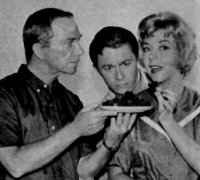 ______________
______________ 
The actors' hopes for the second season included exploring the philosophy of the Martian and focusing more on the newspaper office, as well as touching upon some serious themes from time to time. But instead, the focus became centered on the Martian's inventions and wild situations, perhaps in keeping up with the slew of fantasy sit-coms that premiered in the 64-65 season, many of which blatantly copied gimmicks and plot lines from MFM (a fact which did not escape the press that year). Also, an article mentioned that one of the reasons for the shift in focus of the show might have been to reflect perceived fan desire.
At the start of the second year, Tim still refers to Mr. Burns as his boss, but mid-way through the season, Tim now holds phone conversations with a Mr. Benson, his new boss, though we never get to see the character.
The character of Detective Bill Brennan, antagonist to the Martian, was introduced in the fifth episode of the second season. Alan Hewitt interviewed for the part that summer, being told it might work out to a semi-regular role. The producers liked his performance, and the character was written into 13 episodes of the second season and 14 shows in the last season.
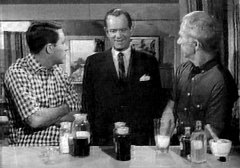 _____________
_____________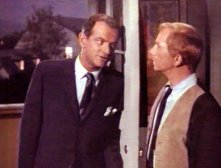
LANGUAGE
An interesting moment came on the March 27, 1965 episode "We Love You, Miss Pringle". Thanks to Martin, Tim’s former strict high-school English teacher is finally honored at her retirement. Exquisitely played by Doris Packer, the cold-mannered Miss Pringle, although clearly moved and overwhelmed at receiving a gold watch, masks the moment by managing to quip, "Damn thing probably doesn’t even keep time…" marking the first occasion that the "d" word was ever heard on a situation comedy. Whether or not it was an ad-lib is academic to the fact that the censorship envelope was pushed a bit.
NAME
It is in this same episode that Uncle Martin reveals his Martian name, Exigious 12 ½ .* The name is spoken again in the third season's episode where in an alternate time line, the Martian's 11 year old nephew lands on Earth, too.
*sincerest thanks to Wayne Stam for supplying the correct spelling (10/23/06)
POE vs HAWTHORNE
A literary "faux pas" occurred in the second season's "Crash Diet" episode. In it, the Martian remarks that Nathaniel Hawthorne wrote "The Purloined Letter", when in fact the story was penned by Edgar Allan Poe. But six weeks earlier, in the episode about Martian hay fever, Martin does correctly identify Poe as the author of The Purloined Letter, and in fact, he and Tim briefly discuss the point. Could it be that the episodes were televised out of sequence and that the discussion on Poe was written to rectify the mistake? Or might it have simply been an oversight on the "Crash Diet" episode? Given the pressure of a weekly TV series, anything is possible.
CRUSH
The phenomenal success of 1964's The Man From U.N.C.L.E. (and the James Bond films) set off a spy craze that swept television in the mid-60s, to the point that it was almost obligatory for a TV series to do a script which involved secret agents. My Favorite Martian found particular success with its version that parodied the "U.N.C.L.E." nemesis THRUSH with its own encounter of an evil spy network named CRUSH. This concept injected the series with a dose of adventure that worked well, and additional encounters with CRUSH were written twice more for the series during its third season.
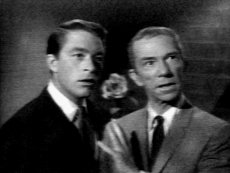 ______
______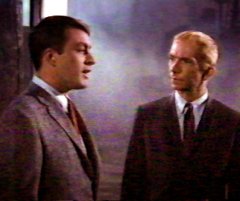 ______
______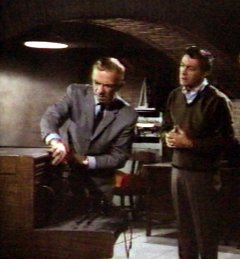
RATINGS
Newsweek reported MFM at #6 in the ratings for the month of Sept. 1964, and for Oct 4th, the Arbitron rating system put the show at #7 with a rating of 23.9. The rest of that month found it at #11 and for November it was #14 with a rating of 24.9. The Nielsen chart gave it 27.8 for October ranking it at #10 and later #8. Throughout the rest of the year it seemed to rank between #12 to #18, and finished out the Nielsen 64-65 season at #24 with an average rating of 23.7.
.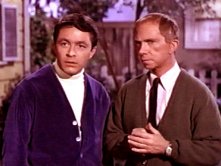 …..
…..
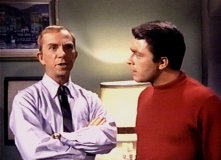 …..
….. 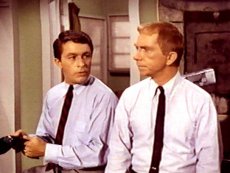
For the third season CBS chose My Favorite Martian as one of 9 primetime shows to be filmed in color as part of its change-over to regularly broadcasting color television. Along with My Mother the Car and Voyage to the Bottom of the Sea, (a competing ABC program at 7 PM Sundays), My Favorite Martian became one of only three sci-fi/fantasy shows of the 65-66 season filmed in color, as Bewitched, I Dream of Jeannie, The Munsters, The Addams Family, The Smothers Brothers Show, and Lost in Space were still being done in black and white.
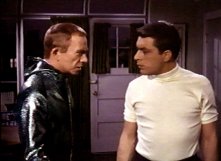 ….
…. …..
…..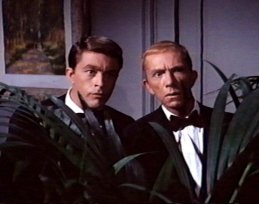
But in the summer of 1965, Lucille Ball, head of Desilu, decided that the studio needed back the soundstages being rented to Jack Chertok productions, as the studio was committed to developing a new series called Star Trek. Since Jack Chertok’s other series, My Living Doll (which was also filmed at Desilu) had been canceled, thus releasing one sound stage back to the studio, it seemed expedient to ask him to take "Martian" elsewhere for its third season production site.*
*(added 4/27/05 with sincerest thanks to Peter Greenwood)
For My Favorite Martian, this factor necessitated a change to MGM Culver Studios in order to take advantage of not only its color filming facilities, but its backlot as well. Production costs for shooting in color came to $70,000 an episode, which might have accounted for why only 32 episodes were filmed that year, as opposed to at least 37 for the black and white seasons. Newspaper interviews from that time have the actors speak enthusiastically of a change back to more adult scripts, along with getting out of the apartment due to plots with the time machine at varied locales. Actually, almost every show in the color season had stories that required additional sets to be built, which might explain the higher budget for that year.
Production for the season opener, "Go West,Young Martian" took place on location at MGM’s lot 3, site of the "Showboat" river set on the northeast end of the studio near Jefferson Blvd. In those days it was unusual for a situation comedy to go on location, and in fact, director David Alexander received a nomination from the American Cinema Editors as Best Director of a Television Film for Part 2 of "Go West". Today, only the trees remain from this famous MGM locale. The MGM soundstage 14 (note: MFM production shooting schedules from Jan.1966 name it as Stage 25) was large enough to accommodate not only the interior and exterior apartment sets, but all the additional sets built for each episode.**
**(added 3/29/02 with a special thanks to Sylvia Stoddard)
Summer articles also hinted at other additions to the third season storylines, including a steady girl friend for Tim. But the only predicted changes that came to pass were the two appearances of Mrs. Brown's scheming brother Alvin, and, in what seemed to be preparation for a fourth season, the introduction in one episode of the Martian's 11 year old nephew, also to be marooned on Earth. But this show was televised only once (Feb 27, 1966) and never again referred to, nor rerun, the implication being that the events in that episode should be ignored.
1965 MGM Production Sheet (added 4/20/06)
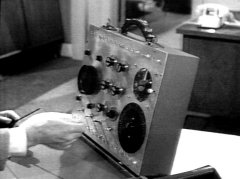 ______
______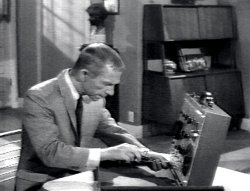 _____
_____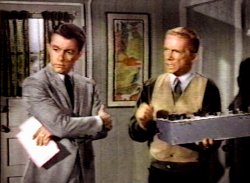
The introduction of the time machine (better known as the Cathode Ray Centrifugal Time-Break-A-Scope or "CCTBS") hit a sudden internal snag. Originally slated as simply one of the last episodes of the black and white second season, "Time Out for Martian" (a story about a trip back to 1215 England) was due to air June 20, 1965, only to be suddenly yanked at the last minute by CBS and a rerun shown instead.. Speculation suggests that when the production staff learned that MFM would be renewed in color, they may have decided it would be far better to introduce the Martian’s time machine in nothing less than a two-part color episode to kick off the 3rd season. Consequently, they must have prevailed upon CBS to support this decision, which the network did, obligingly shelving the black and white "Time Out for Martian" show until a year later, airing it finally on May 8, 1966, as the last first-run show of the series.
THE LION
During the third season, the infamous " lion" episode took place. It happened on "Stop the Presses, I Want to Get Off". According to two separate accounts of the incident told on talk shows, Ray Walston, being all too aware of the dangers of working with animals, refused to do a scene near a lion, but Bill Bixby gladly offered to do the scene instead and it was rewritten accordingly. It seemed simple enough, as the lion was to be on one side of a two inch thick glass wall, and Tim (Bill) would be standing on the other side. The script called for him to see the beast and shake a bit. But as the cameras were rolling, the lion (reputed to be old and without teeth) suddenly gave a roar, leaped right at the clear partition and the glass went flying in all directions! Stunned, the lion just stood there, blinking, but unhurt. Meanwhile, the alert Bixby, having instantly fled the scene, was off the set, off the sound stage, out of the studio and, as Ray Walston kiddingly claimed, he couldn’t find him for 3 hours. Bill’s version was that he did indeed shoot right up a ladder to the rafters, only to find Ray already up there, since he had known better in the first place.
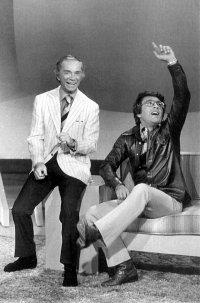 (Bill Bixby telling his version of the lion story on "This Is Your Life" Nov. 1971)
(Bill Bixby telling his version of the lion story on "This Is Your Life" Nov. 1971)
CANCELLATION
As was often the case, there was not one clear-cut answer given for My Favorite Martian’s cancellation in March 1966. One factor mentioned was that the scripts were not going the way they should have been going. Sponsor resistance possibly because of ratings was cited, as well as CBS’ rejection of the premise of the new nephew character.
Now more details about this development have recently become known. Due to Ray Walston’s dissatisfaction with the direction of the scripts, he wanted to limit his appearances on the program. By introducing the character of his 11 year old nephew Andromeda, the producers saw a way to keep the series going and yet not require Uncle Martin to be in every episode. The premise would have been for Uncle Martin and Andromeda to have returned to Mars in the first episode of the fourth season, but the boy would then have been sent back to Earth to learn not to be flawed like humans, with Uncle Martin checking in on him from time to time.
But CBS was not interested in this concept and cancelled the series. It was then offered to ABC, but, after a few days, they also passed, due to the lack of Mr.Walston’s full-time participation in the show.*
*added 2/3/07 with kindest and sincerest thanks to Peter Greenwood for this information
In any event, MFM ended its production run on Feb 10, 1966 and the last rerun was "Pay the Man the 24 Dollars", televised Sept. 4, 1966.
SYNDICATION…....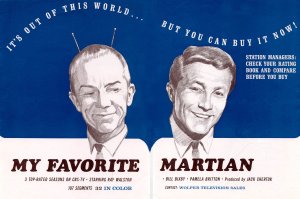 ……..
……..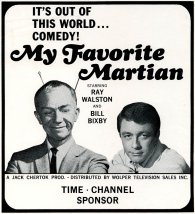
My Favorite Martian immediately went into syndication in the fall of 1966 through Wolper Productions, which advertised it as having achieved an average 38.2 share of the audience over the course of its three year network run. During its syndication years, it delivered an audience of 56% teens and kids and 44% adults, with 75% of those adults between 18-49. In 1973, Filmation produced a 13 episode cartoon version My Favorite Martians based on the premise of the Martian's teenage nephew Andromeda also being marooned on Earth. It was televised Saturday mornings on CBS with no participation by any of the original cast, although producer Chertok was credited as a "Creative Consultant". Then in 1983 Telepictures brought the filmed series back into syndication with cleaned-up 35mm prints transferred to video. Rumors of a reunion TV-movie surfaced in 1986, but when this project was dropped in favor of producing a syndicated series under very long, hard working hours, tough conditions and a poor premise, the actors were unavailable for such a commitment and the new series never happened.
THE TV MOVIE THAT NEVER WAS
In 1992 talks were underway for a reunion of My Favorite Martian as a TV Movie. Bill Bixby and Ray Walston had agreed to recreate their roles, and Bill was slated to direct the film. Its premise was that Uncle Martin had spent a good number of years on Earth, but that he had finally returned to Mars and was now put in charge of the Earth Culture section of a Martian museum. But he dislikes the assignment, and, after seeing how groups of Martian children are ridiculing an Earth probe on display, Martin says, "That’s it!!" and takes the nearest spaceship to head for Earth.
It is the 1990s and Tim O’Hara is now an editor for his newspaper. His son has just started working for the paper and there is conflict with his father over the types of routine assignments he is being given. Tim had bought the house from Mrs. Brown where he now lives and his son is occupying the apartment over the garage. Uncle Martin arrives and, being apprised of the situation, endeavors to take Tim’s son under his wing to help him understand his father’s position and concerns regarding the newspaper job situation.
The project was at the point of getting the rights from Jack Chertok, but very sadly, Bill Bixby’s health had begun to decline at that time and the movie was abandoned.*
*(added 4/26/05 with sincerest thanks to Peter Greenwood)
My Favorite Martian then, consists of 107 episodes, 32 in color, with additional stories found in the nine Gold Key comics issued, and some stories and comics published only in England. However, the story of how the Martian returns to his Red Planet has yet to be told.

More details on the production of the series can be found on
the special bonus features and interviews on
MY FAVORITE MARTIAN: Season 3 DVD
And
MPI Collector’s Edition My Favorite Martian Season 3
text© 1998-2012 by JH Harison
(Top B&W photo, © Gene Trindl for TV GUIDE; First Season (left) photo © Jack Chertok Productions, Inc; Special Effects: both photos © Jack Chertok, Productions, Inc; Second Season (left) photo © Jack Chertok Productions, Inc.; Photo "Behind the Scenes: Nose for News" © Associated Press; Photo
**"Behind the Scenes: Nothing But The Truth" © Associated Press from The History of Television, 1991, "This Is Your Life" ©Ralph Edwards Productions)Sources of information: Rocky Mountain News, Oct 27, 1963; Seattle Times, Sept. 8, 1963, Oct. 13,1963; Newark Evening News, May 17,1964; Boston Sunday Advertiser TV section, April 12,1964; Chicago Tribune, Sept 22, 1963, Aug. 29, 1965; Philadelphia Inquirer, Aug. 15, 1965; San Francisco Examiner, June 15, 1965, Sept. 5,1965; Los Angeles Times, May 14, 1964; The TV Collector, April 1983; TV GUIDE, Nov. 2, 1963, April 12, 1964; TV Star Parade, March 1965, Sept. 1965; STARLOG Magazine # 50; #157; Variety;
Television Series Regulars of the 50s & 60s by D. Kulzer (1992). TV SHOWS: The Woody Woodbury Show (5/23/68) The Mike Douglas Show (3/24/72) This Is Your Life (Nov 1971)This website is non-profit for fan and educational purposes only. No infringement of rights is meant or implied. All copyrighted quotes and photographs are held by their respective publications and companies. Original screen capture images and text found on this site may not be reproduced without prior consent of JH Harison.
/home/ /reviews/ /schedule/ /season 1/ /season 2/ /season 3/ /characters/ /influence/ /trivia/ /bibliography/